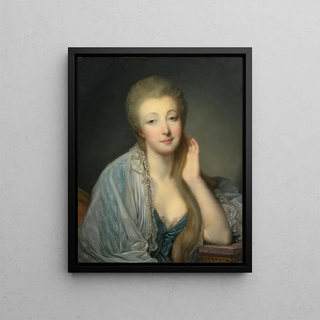Art print | Portrait of Countess Du Barry - Jean-Baptiste Greuze


View from behind

Frame (optional)
Portrait of the Countess Du Barry - Jean-Baptiste Greuze – Captivating Introduction
The "Portrait of the Countess Du Barry" by Jean-Baptiste Greuze is much more than a simple pictorial representation; it is an open window into the elegance and intrigues of the French court in the 18th century. This iconic artwork captures not only the beauty of Louis XV's famous mistress but also the essence of an era where art and social life intertwined intimately. The delicacy of the countess's features, the richness of the colors, and the depth of emotions conveyed by the painting make each gaze upon this piece an invitation to a journey through time. The art print of this masterpiece allows everyone to immerse themselves in the refined atmosphere and aesthetic subtleties that marked this period.
Style and uniqueness of the work
The uniqueness of the "Portrait of the Countess Du Barry" lies in how Greuze manages to combine realism and idealization. The artist, known for his ability to capture the nuances of human psychology, depicts the countess with such finesse that the viewer cannot help but feel an emotional connection. The meticulous details of her dress, adorned with lace and embroidery, are rendered with precision that testifies to Greuze's exceptional craftsmanship. The soft, enveloping light caresses the countess's face, revealing a beauty that is both fragile and powerful. Every element of the composition, from the delicately blurred background to the pensive expression of the countess, contributes to creating an intimate, almost personal atmosphere that invites contemplation.
The artist and his influence
Jean-Baptiste Greuze, a major figure of the 18th-century artistic movement, established himself through his unique style and his ability to tell stories through his portraits. Influenced by the great masters of painting, he developed a personal approach, blending emotion and technique. Greuze particularly marked his era with his portrayal of feelings, offering a more human and accessible vision of noble characters. His work has inspired many artists, both through his technique and his vision of portraiture, thus redefining the conventions of the

Matte finish

View from behind

Frame (optional)
Portrait of the Countess Du Barry - Jean-Baptiste Greuze – Captivating Introduction
The "Portrait of the Countess Du Barry" by Jean-Baptiste Greuze is much more than a simple pictorial representation; it is an open window into the elegance and intrigues of the French court in the 18th century. This iconic artwork captures not only the beauty of Louis XV's famous mistress but also the essence of an era where art and social life intertwined intimately. The delicacy of the countess's features, the richness of the colors, and the depth of emotions conveyed by the painting make each gaze upon this piece an invitation to a journey through time. The art print of this masterpiece allows everyone to immerse themselves in the refined atmosphere and aesthetic subtleties that marked this period.
Style and uniqueness of the work
The uniqueness of the "Portrait of the Countess Du Barry" lies in how Greuze manages to combine realism and idealization. The artist, known for his ability to capture the nuances of human psychology, depicts the countess with such finesse that the viewer cannot help but feel an emotional connection. The meticulous details of her dress, adorned with lace and embroidery, are rendered with precision that testifies to Greuze's exceptional craftsmanship. The soft, enveloping light caresses the countess's face, revealing a beauty that is both fragile and powerful. Every element of the composition, from the delicately blurred background to the pensive expression of the countess, contributes to creating an intimate, almost personal atmosphere that invites contemplation.
The artist and his influence
Jean-Baptiste Greuze, a major figure of the 18th-century artistic movement, established himself through his unique style and his ability to tell stories through his portraits. Influenced by the great masters of painting, he developed a personal approach, blending emotion and technique. Greuze particularly marked his era with his portrayal of feelings, offering a more human and accessible vision of noble characters. His work has inspired many artists, both through his technique and his vision of portraiture, thus redefining the conventions of the






